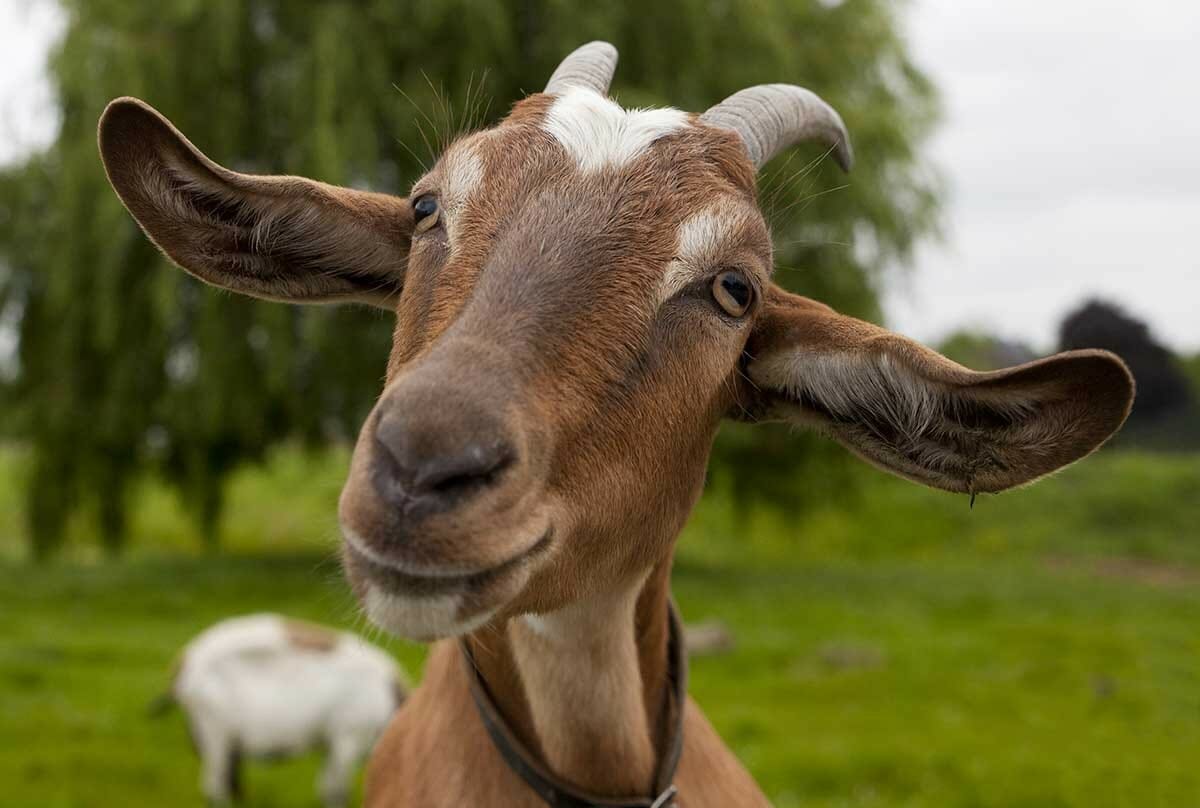How to Encourage Good Hygiene in Goats: Hoof, udder and intestinal health form the holy trinity of goat hygiene.

[mf_h4 align=”left” transform=”uppercase”]Hoof Care[/mf_h4]
Frequency: Monthly
Goat nails grow fast and need to be trimmed regularly to prevent nasty infections and avoid long-term joint problems. In the rocky mountain crags where their wild ancestors dwelled, the constant scraping of hoof against rock kept goat hooves in good shape. In the barnyard, however, goats need our help to care for their hooves. If left untrimmed, goat hooves become long, curved and pointy, impacting their gait, leading to arthritis and possibly lameness and even death. Soil and feces become packed into the center of the hooves, causing festering sores and hoof rot, a potentially fatal disease.
- Restrain the goat on a milking stand and distract it with a bucket of its favorite food. Kid goats can be restrained in the lap of a helper until they are big enough to use a milk stand.
- Gently place one hand near the top of a leg and slide it slowly down to the bottom, so the goat is not startled by the contact.
- Pick up the leg so the bottom hoof is facing up and use the tip of the trimming shears to dislodge compacted soil and feces from the center of the hoof.
- Cut off the portion of the hoof that extends beyond the flat, fleshy sole at the center of each toe, removing a thin strip with each cut until the nail and sole are flush with each other. If the cut surface of the hoof becomes pink (instead of white) as you cut, it’s a sign that you are getting close to active blood vessels and the hoof should not be trimmed further.
- Repeat the process with the other hooves.
Some goats are calm and cooperative during the trimming process, but most will resist it, especially those that are not accustomed to a high degree of contact. It’s important to work quickly while they are distracted by the food, but it may be necessary for a second person to restrain the goat’s movement during the trimming process. If your goat barn is not lit up like a laboratory, wear a head lamp while trimming so you can see exactly what you’re doing.
The tissue beneath the hoof, called the ‘quick,’ contains blood vessels that don’t easily clot if they are cut, so a clotting agent should be kept on hand when trimming.
[mf_h4 align=”left” transform=”uppercase”]Udder Love[/mf_h4]
Frequency: Daily
A little disinfectant and bag balm go a long way to prevent teat problems. Following a simple hygiene protocol before and after milking promotes healthy, productive udders and keeps mastitis and other serious infections at bay.
- Clean the teats before milking with a solution of warm, soapy water, such as Dr. Bronner’s all-purpose soap. Dry with a paper towel.
- Disinfect the teats after milking with an iodine or chlorohexadine-based teat dip or teat spray.
- Check the teats and udders for signs of chapped, cracked or irritated skin and, if necessary, massage with udder balm after milking.
There are as many theories on how to care for goat udders as there are goat farmers. But there is no question that disinfection is an important component, whether you favor chemical or all-natural udder care products.
[mf_h4 align=”left” transform=”uppercase”]Parasite Prevention[/mf_h4]
Frequency: Daily, Weekly and Monthly
Intestinal parasites are the most common source of poor health in goats. They are highly contagious and once they invade a herd, they’re hard to exterminate. Goat feces should be in the form of firm pellets – if runny poop is observed, the sick goats must be treated quickly as severe, ongoing cases of diarrhea can cause death in just a few weeks.
The more widely your goats can roam, the more space they have in the barn and the more varied their diet is with wild plants, the fewer parasites they will have. Low levels of parasites are unavoidable; your job is to manage the herd to prevent an unnatural buildup of parasites to the degree where illness occurs.
- Position water and food troughs at the correct height – there’s only a few inches difference between low enough to eat or drink from versus high enough to prevent fecal contamination. In other words, mount troughs at the greatest possible height that still allows the goats to eat and drink comfortably.
- Clean soiled troughs immediately with soapy water.
- Clean troughs weekly even if they are not visibly soiled.
- Provide clean straw and a dry, draft-free environment for bedding at all times.
- Rotate goats to fresh pasture as often as possible.
Some parasites don’t cause scouring (the technical term for diarrhea in goats), making it hard to know when a serious health problem is lurking. For this reason, it’s important to check your goats monthly for signs of anemia, which is the other primary indicator of parasites. There are two ways to do this:
- Put your thumb on the skin below the eye and draw the skin downward to check the color of the mucous membranes at the bottom of the eye – they should look bloodshot if the goat is healthy. Light pink or white eyes are a sign of anemia.
- Pull back the lip on the side of the jaw and press firmly into the gums with your thumb. Blood should come rushing in when you release the gums, causing them to look deep pink or red in color; if they remain pale, it’s a sign of anemia.
Seemingly minor ailments tend to progress quickly in goats without intervention. If unusual symptoms present themselves (diarrhea, gauntness, difficulty walking, discolored milk, tender udders, etc), consult with a vet for a diagnosis. By adopting a good hygiene regimen, you’ll avert the vast majority of serious goat ailments and keep the vet – and hefty vet bills – away.